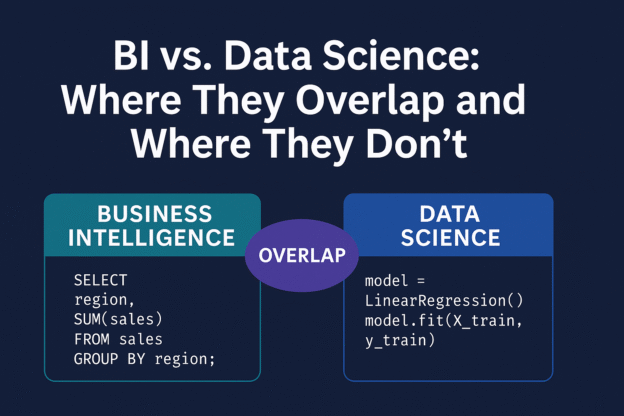If you’ve worked with data at any level—business analyst, marketing manager, or even startup founder—you’ve probably heard the terms Business Intelligence (BI) and Data Science thrown around. Sometimes they seem interchangeable. Other times, people treat them like polar opposites.
So what’s the real story?
In this guide, we’ll break down what BI and Data Science actually mean, where they cross paths, and how to decide which approach (or role) fits your needs best.
What is Business Intelligence (BI)?
BI is all about using data to understand what’s already happened and why.
It helps businesses answer questions like:
- How did we perform last quarter?
- Which products sold the most?
- Which region had the highest revenue?
Most BI work revolves around:
- Dashboards
- Reports
- Visual analytics
- KPIs (Key Performance Indicators)
You’ll usually find BI sitting at the intersection of data and business—helping decision-makers monitor performance and act quickly.
Popular BI tools:
- Power BI
- Tableau
- Looker
- Excel
- SQL
What is Data Science?
Data Science is about using data to predict what might happen next—or even suggest what to do about it.
Think:
- Forecasting next month’s sales
- Predicting customer churn
- Recommending the right product to the right user
Data Science leans heavily on:
- Statistics
- Machine learning
- Scripting (usually Python or R)
- Custom models
It’s more technical than traditional BI, and often part of bigger data or AI projects.
Popular tools for Data Science:
- Python (with pandas, scikit-learn, etc.)
- Jupyter Notebooks
- R
- Spark or Databricks
- TensorFlow / PyTorch
So… How Are They Different?
Let’s break it down in plain language:
| Topic | Business Intelligence | Data Science |
|---|---|---|
| Main Question | “What happened?” | “What will happen?” / “What should we do?” |
| Focus | Past performance, tracking metrics | Prediction, modeling, optimization |
| Tools | Drag-and-drop tools, dashboards, SQL | Code-heavy tools (Python, R, ML libs) |
| Users | Business users, analysts, ops teams | Data scientists, engineers, product teams |
| Output | Dashboards, visual reports | Predictive models, insights, simulations |
Where BI and Data Science Overlap
Despite their differences, these two aren’t enemies—they’re teammates.
Here’s where they often meet:
1. Data Preparation
Both fields need clean, structured data. Whether it’s for a dashboard or a machine learning model, 80% of the work is often cleaning and transforming messy data.
2. SQL Skills
SQL is the universal language of data. Whether you’re building a BI report or feeding a model, you’ll probably write queries to pull your data.
3. Storytelling with Data
Both BI professionals and data scientists need to communicate findings to non-technical stakeholders. That might mean dashboards, visualizations, or presentations.
4. Driving Better Decisions
At the end of the day, both roles aim to help the business make smarter, data-backed decisions.
Where They Don’t Overlap
Here’s where things start to diverge:
| Area | Only BI Does This | Only Data Science Does This |
|---|---|---|
| Real-time KPI dashboards | ✅ | ❌ |
| Self-service reporting | ✅ | ❌ |
| Machine learning models | ❌ | ✅ |
| A/B testing strategy | ❌ | ✅ |
| Forecasting using regression | ❌ | ✅ |
Real-Life Examples
Let’s say you work for an e-commerce company:
Example 1: BI Use Case
The marketing manager wants to know how last week’s sales performed across channels. A BI dashboard answers that in seconds.
Example 2: Data Science Use Case
The data science team builds a model to predict which users are likely to abandon their carts—and automatically sends them reminders.
See the difference? BI = monitor and understand. Data Science = predict and act.
Choosing the Right Approach
| If you want to… | Use… |
|---|---|
| Track real-time sales | ✅ Business Intelligence |
| Forecast inventory needs for next quarter | ✅ Data Science |
| Build dashboards for executives | ✅ Business Intelligence |
| Create a customer churn model | ✅ Data Science |
| Analyze what happened in Q2 | ✅ Business Intelligence |
| Simulate pricing changes | ✅ Data Science |
Career Perspective: BI vs. Data Science Roles
| Role | Focus | Typical Tools |
|---|---|---|
| Business Analyst | Reporting, process improvement | Power BI, Excel, SQL |
| Data Analyst | Data wrangling + visualization | SQL, Python, Tableau |
| Data Scientist | Modeling, experimentation | Python, Jupyter, ML tools |
| BI Developer | Building dashboards, data models | DAX, Looker, SQL, Power BI |
You’ll often find BI roles embedded in business teams, while data scientists work more closely with engineering and product teams.
Final Thoughts: You Need Both
It’s not about BI vs. Data Science—it’s BI and Data Science.
Think of BI as your rearview mirror—helping you see what just happened and make quick decisions. Data Science is more like your GPS—showing you the road ahead and suggesting the best route forward.
Together, they form a powerful combo for any modern, data-driven business.
Discover more from Daily BI Talks
Subscribe to get the latest posts sent to your email.

